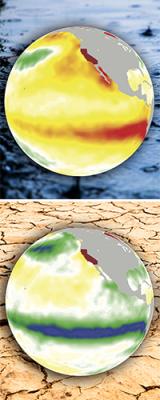Pacific Ocean patterns fueled by climate warming may launch more extreme weather
After a season of wildfires, Californians are begging for rain to end the drought. But a lesson in "be careful what you ask for" might be in store for the Golden State. Researchers at Pacific Northwest National Laboratory have found that the weather patterns known as El Niño and La Niña could lead to at least a doubling of extreme floods and droughts in California later this century. The study, simulating historical and future climate outcomes, was published in the online journal Nature Communications.
"Wet and dry years in California are linked to El Niño and La Niña. That relationship is getting stronger," said atmospheric scientist Jin-Ho Yoon at PNNL. "Our study shows that ENSO [see sidebar, ENSO] will be exhibiting increasing control over California weather."
Current research suggests future rain will come down more as light drizzles and heavy deluges and less as moderate rainfall. Yoon and colleagues from PNNL and Utah State University in Logan, Utah, wondered if droughts might follow a similar pattern. Looking at what happens to California in global climate models, they simulated two periods of time: 1920 to 2005 using historical measurements; and 2006 to 2080 using conditions in which very few efforts are made to reduce greenhouse gas emissions.
The models showed that in the future, assuming emissions continue to increase, California seasons will exhibit more excessively wet and excessively dry events. These results suggest that the frequency of droughts could double and floods could triple between the early 20th century and late 21st century.
"By 2100, we see more and more extreme-events. Flooding and droughts will be more severe than they are currently," said Yoon.
California is experiencing one of the most severe droughts in its history, but it's not clear if a warmer world will make droughts worse, more frequent or perhaps even improve the situation. After all, warmer air can hold more water, and some research suggests global warming could increase California's average rain and snowfall. Using global climate models is a way that scientists can size up climate outcomes using inputs of historical measurements and estimates of future conditions, depending on whether greenhouse gases are held steady, increase, or decline.
Comments from four anonymous reviewers are helpful in improving the manuscript and.are highly appreciated. Computational resources from Oak Ridge Leadership Computing Facility under the ASCR Leadership Computing Challenge (ALCC) project to Pacific Northwest National Laboratory, from National Energy Research Scientific Computing Center (NERSC), and from Environmental Molecular Science Laboratory (EMSL) at PNNL are greatly acknowledged for the sensitivity experiments and data analysis. We appreciated the CESM1 (CAM5) Large Ensemble Community Project performed with supercomputing resources provided by NSF/CISL/Yellowstone. We acknowledge state boundary file and fruitful discussions with Dr. Maoyi Huang at PNNL, an internal review and graphical assistance by Dr Kyo-Sun Sunny Lim at PNNL, and a programming/.graphical assistant by Danny Barandiaran at USU. J.-H.Y., B.K. and P.J.R. are supported.by the Office of Science of the US Department of Energy as part of the Earth System Modeling program. B.K. is also supported by the Fund for Innovative Climate and Energy Research (FICER). PNNL is operated for the Department of Energy by Battelle Memorial Institute under the Contract Number DEAC05-76RLO1830. The CESM project is supported by the National Science Foundation and the Office of Science of the.US Department of Energy. S.-Y.S.W. and R.R.G. are supported by the BOR Water-.SMART grant R13AC80039 and NASA grant NNX13AC37G.


